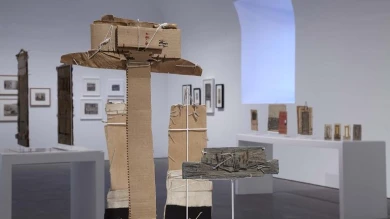Martín Ramírez
Reframing Confinement
Ramírez emigrates to California where he works for five years as a miner and on the railroads. In 1931, in the midst of the Great Depression and with no job and no roof over his head, he is taken into custody because of his state of confusion and inability to communicate, and is then admitted to a psychiatric hospital after being diagnosed as an incurable manic depressive and catatonic schizophrenic. This period sees him begin his artistic output and in 1948 he is transferred to another hospital where he continues his work until his death in 1963 - his oeuvre, produced in complete reclusion, spans 32 years, with 450 drawings being conserved.
During his years of confinement Ramírez barely speaks, instead inventing an artistic style based on flexible linear structures and certain aspects inspired by Mexican and American cultures. His drawings are more of a refuge than a means of expression and in them he obsessively reiterates a series of recurring themes - tunnels, a rider mounted in the saddle, fields and rail tracks - which he develops in an expressive range of languages and forms.
Ramírez lives and creates in isolation from the world, unaware of any art movements and information. The interest in Ramírez' work arises from doctor Tarmo Pasto, a professor of Psychology and Art in the hospital he was an inmate in, as he organises exhibitions in the Fifties without revealing the names of his hospitalised patients. Following Ramírez' death, diverse individual exhibitions are held and warmly received by gallery owners and artists alike, so much so that his work receives widespread acclaim in 2007 with the large retrospective in the American Folk Art Museum in New York. This exhibition also works to re-evaluate the art work by this outsider by placing it within a new museum context and unearthing the role of those that remain excluded from dominant artistic discourses.
Artists
Organised by
Museo Nacional Centro de Arte Reina Sofía
Image gallery





